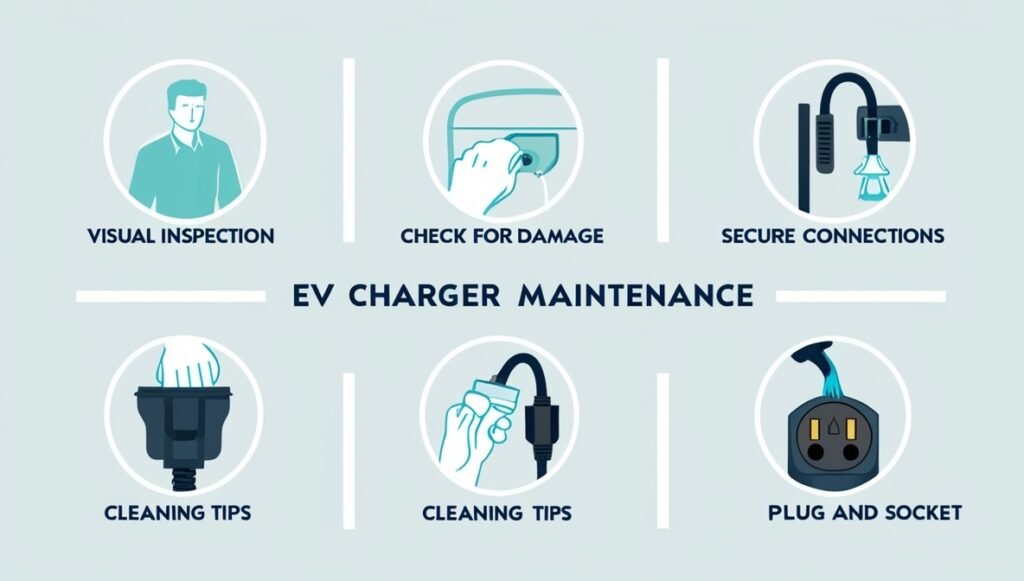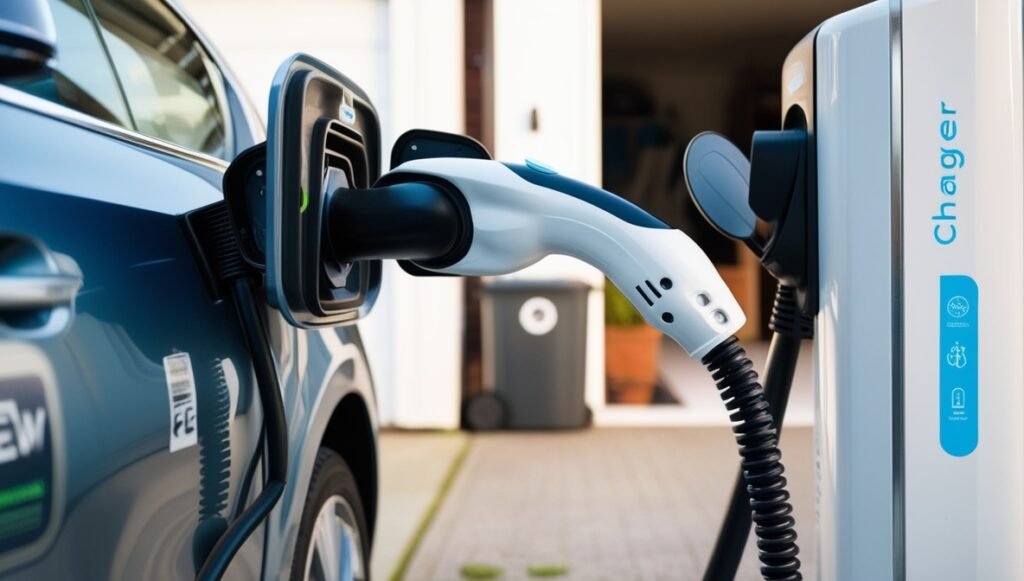Electric vehicles (EVs) continue to gain popularity across the UK, with over 740,000 EVs registered by 2023 (SMMT). As EV ownership rises, EV charger maintenance is critical for reliable, safe, and efficient charging. Proper maintenance extends your charger’s lifespan, optimizes performance, and ensures safety standards are upheld. This guide provides actionable steps for maintaining your EV charger, backed by insights from industry experts, real-world examples, and authoritative sources.
Why EV Charger Maintenance is Essential
Maintaining your EV charger is about more than just cleanliness; it’s essential for safety and long-term performance. Dr. Sarah Mills, an EV infrastructure specialist at the University of Leeds, emphasizes, “Regular maintenance of EV chargers not only improves safety but also enhances charging efficiency, saving time and costs over the long term.”
For more on choosing the right charger for your home, check out our Best Home EV Charger UK (2024 Guide).
Interesting Fact: In 2023, the UK added 13,706 rapid and ultra-rapid charging devices, reflecting a 53% growth in just 12 months (Zap-Map).
Key Benefits of EV Charger Maintenance
- Extend Charger Lifespan: Research indicates that regular maintenance can extend a charger’s life by up to 50%, saving on replacement costs (SMMT).
- Ensure Safety: Poorly maintained chargers can pose risks like electrical fires. Routine inspections help prevent hazards, protecting both your home and vehicle.
- Optimize Efficiency: Well-maintained chargers offer faster, consistent charging speeds, ensuring your EV is ready when needed.
According to Zap-Map’s 2024 forecast, the number of home chargers is expected to grow by 40%, underscoring the importance of maintaining this growing infrastructure Zap-Map.
Understanding different charging speeds is crucial for effective EV charger maintenance. Chargers that support rapid or ultra-rapid speeds may require more frequent checks due to higher power use. For more on how charging speeds impact charger care, see our guide: EV Charging Speeds Explained: Rapid vs. Slow Charging.
Common Issues with EV Chargers
Despite technological advances, EV chargers can still encounter common issues. Addressing these problems early is crucial for effective maintenance.
1. Faulty Connections and Loose Cables
Loose connections are common with regular use. John Taylor, CEO of ChargedEV, explains, “Regular inspections for frayed or loose connections are essential, as small faults can escalate quickly.” Replace any worn cables to avoid safety risks.
Apartment dwellers often face unique challenges with EV charging setups, as shared spaces and outdoor installations may increase exposure to environmental factors and loose connections. If you’re an apartment resident, you may benefit from our guide on 7 Best EV Charging Solutions for UK Apartments (2024).
Interesting Fact: Greater London leads the UK with 21,965 public charging points, followed by the South East with 8,732 (Zap-Map).
2. Power Supply Fluctuations
Power surges can impact charger performance. Installing a dedicated EV circuit breaker or surge protector is advised. The Office for Zero Emission Vehicles (OZEV) recommends surge protection devices as a proactive measure (GOV.UK).
Interesting Fact: The proportion of ultra-rapid chargers (150kW+) has grown from 36% in 2021 to over 64% in 2024, reflecting a move towards faster charging (Zap-Map).
3. Overheating Chargers
Overheating is a major concern during high-power charging. Chargemaster UK reports that 15% of charger malfunctions are related to overheating. Keeping chargers shaded and ventilated helps manage this risk.
Step-by-Step EV Charger Maintenance Checklist

Follow this detailed checklist to keep your EV charger in optimal condition.
1. Visual Inspection
- Check for Damage: Inspect cables and units for visible damage, like cracks or corrosion.
- Secure Connections: Ensure plugs and sockets are tightly connected.
Real-World Example: Pod Point reports that regular annual EV charger maintenance reduces malfunctions by 30%, extending the life of chargers (Pod Point (https://pod-point.com)).
Image Prompt for Visual Inspection Checklist Image
Prompt: “Design an infographic that visually represents an EV charger maintenance checklist. Include icons for ‘Visual Inspection,’ ‘Check for Damage,’ ‘Secure Connections,’ ‘Cleaning Tips,’ and ‘Inspecting the Plug and Socket.’ Use clean, modern graphics with soft, professional colours to illustrate each step clearly.” Size: 800×800 pixels
Placement: Under the “Step-by-Step EV Charger Maintenance Checklist” section, right after introducing the checklist.
2. Cleaning Tips
Follow these cleaning practices as advised by Nissan’s EV Maintenance Guide (Nissan UK (https://www.nissan.co.uk)):
- Use Approved Solutions: Avoid harsh chemicals; use solutions suitable for electrical equipment.
- Unplug Before Cleaning: Always disconnect before cleaning to prevent hazards.
3. Inspecting the Plug and Socket
- Check for Wear: Regularly inspect for any signs of wear or burning as part of EV charger maintenance.
- Consult a Professional: Seek professional help if issues arise.
4. Software Updates
Modern chargers include software that optimizes performance. Keeping this software updated is vital:
- Check Manufacturer’s App: Apps from brands like Wallbox and myenergi offer monitoring and updates (myenergi (https://myenergi.com)).
- Install Updates Promptly: Updates provide performance enhancements and security patches, which are beneficial for overall EV charger maintenance.
Image Prompt for Future of EV Charger Maintenance Image
Prompt: “Create a futuristic illustration showing an advanced EV charger with built-in diagnostics. Include a display screen with a diagnostic message or alert icon, emphasizing predictive maintenance. The charger is sleek and modern, with an electric vehicle in the background in a contemporary UK neighborhood setting, conveying smart technology and innovation.” Size: 1000×600 pixels
Placement: In the “Looking Ahead: The Future of EV Charger Maintenance” section, at the beginning of the section.
Looking Ahead: The Future of EV Charger Maintenance
The future of EV charger maintenance lies in smart diagnostics and predictive maintenance technologies. Emerging chargers are expected to feature self-monitoring systems that detect faults before they become costly issues. This proactive approach could reduce the need for manual checks, helping EV owners save time and money.
Conclusion
Regular maintenance is crucial for a safe, efficient, and reliable EV charging experience. By following this guide and consulting professionals when necessary, you can ensure your charger’s longevity and safety.
FAQ
How often should I inspect my EV charger?
It’s recommended to perform a visual check monthly and schedule professional inspections annually.Can I clean my EV charger with water?
Avoid using water; instead, use a damp cloth and a suitable cleaning solution designed for electronics.What should I do if my charger overheats?
Disconnect it immediately, let it cool down, and inspect for any visible damage. Seek professional assistance if overheating continues.Is it safe to repair the charger myself?
Minor tasks, like cleaning and visual inspections, are safe. However, for technical issues, always consult a professional to avoid voiding your warranty.How can I protect my outdoor EV charger?
Use weatherproof covers and regularly check for water ingress or corrosion to protect against environmental elements.Are there government grants for EV charger maintenance?
Yes, the UK government offers grants through OZEV for home and fleet chargers. Check eligibility at GOV.UK.
Discover more expert tips and EV maintenance guides on EVCR.co.uk (https://www.evcr.co.uk). Subscribe today for exclusive insights and updates!

